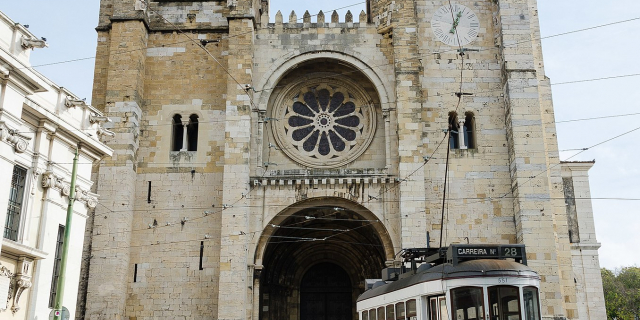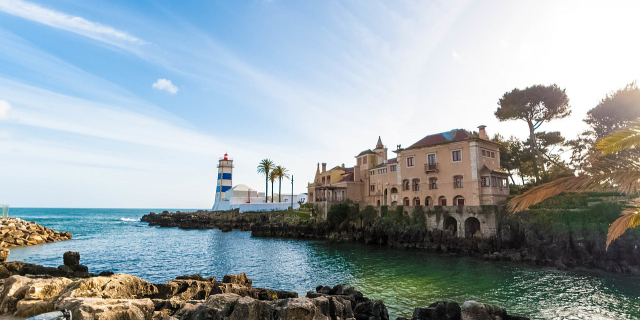Belém Tower (Portuguese: Torre de Belém, pronounced [ˈtoʁɨ ðɨ βɨˈlɐ̃j]; literally: Bethlehem Tower), officially the Tower of Saint Vincent (Portuguese: Torre de São Vicente) is a 16th-century fortification located in Lisbon that served as a point of embarkation and disembarkation for Portuguese explorers and as a ceremonial gateway to Lisbon. This tower symbolizes Portugal's maritime and colonial power in early modern Europe. It was built during the height of the Portuguese Renaissance, and is a prominent example of the Portuguese Manueline style, but it also incorporates other architectural styles, such as the minarets, which are inspired by Moorish architecture. The structure was built from lioz limestone and is composed of a bastion and a 30-metre (100 ft), four-storey tower.
Since 1983, the tower has been a UNESCO World ...Read more
Belém Tower (Portuguese: Torre de Belém, pronounced [ˈtoʁɨ ðɨ βɨˈlɐ̃j]; literally: Bethlehem Tower), officially the Tower of Saint Vincent (Portuguese: Torre de São Vicente) is a 16th-century fortification located in Lisbon that served as a point of embarkation and disembarkation for Portuguese explorers and as a ceremonial gateway to Lisbon. This tower symbolizes Portugal's maritime and colonial power in early modern Europe. It was built during the height of the Portuguese Renaissance, and is a prominent example of the Portuguese Manueline style, but it also incorporates other architectural styles, such as the minarets, which are inspired by Moorish architecture. The structure was built from lioz limestone and is composed of a bastion and a 30-metre (100 ft), four-storey tower.
Since 1983, the tower has been a UNESCO World Heritage Site, along with the Jerónimos Monastery. It is often portrayed as a symbol of Europe's Age of Discoveries and as a metonym for Portugal or Lisbon, given its landmark status. It has incorrectly been stated that the tower was built in the middle of the Tagus and now sits near the shore because the river was redirected after the 1755 Lisbon earthquake. In fact, the tower was built on a small island in the Tagus river near the Lisbon shore.
 The tower was classified as a UNESCO World Heritage Site in 1983 and included in the registry of the Seven Wonders of Portugal in 2007.
The tower was classified as a UNESCO World Heritage Site in 1983 and included in the registry of the Seven Wonders of Portugal in 2007.In the late 15th century, King John II had designed a defence system for the mouth of the Tagus that depended on the fortresses of Cascais and São Sebastião (or Torre Velha) in Caparica on the south side of the river.[1][2] These fortresses did not completely protect the river's mouth, and further protection was required.[2] In his "Chronicle of John II" (Chronica de D. Joao II), which appeared in 1545,[3] the author Garcia de Resende affirmed the king's opinion that the defences of Lisbon were inadequate, and that he had insisted on building fortifications along the entrance to the River Tagus to supplement the existing defences.[4] To this end, he ordered the "making of a strong fort", but died before any plans were drawn. King Manuel I of Portugal revisited the proposal twenty years later and ordered the construction of a military fortification on the northern margin of the Tagus at Belém.[2] In 1513, Lourenço Fernandes wrote a letter to his friends referring to the king's intention of constructing a tower near Restelo Velho, having determined it to be essential.
 Portuguese presence in India , Bengal Gulf and Himalayas (max extend) between the 16th and 17th century.
Portuguese presence in India , Bengal Gulf and Himalayas (max extend) between the 16th and 17th century.The presence of this military element was also a celebration of the round trip of the Portuguese to India and a way of receiving the fleets that arrived at the mouth of the Tagus, glorifying the feat, as if it were a mimetic of what those who arrived could identify with the they had seen in the East. The best example is the carved rhinoceros, the result of an offer from an Indian ruler who offered it to King Dom Manuel. This Rhinoceros would be the same one that Albert Durer would immortalize in his drawings.
The project was started on a basaltic rock outcrop a short distance from the riverbank, using some of the stone being collected to build the Monastery of Santa Maria de Belém. The tower was designed by military architect Francisco de Arruda,[5] named "Master of the works of the Belém stronghold" by King Manuel,[6] and in 1516 he began receiving 763 blocks and 504 stones for its construction, delivered by Diogo Rodrigues, treasurer for the project. As construction progressed, a man-of-war called the Grande Nau (Great Ship), a heavily armed, 1000–ton ship continued to guard the estuary at the mouth of the Tagus until the fort's completion.[7][8]
The building was finished in 1519, just two years before Manuel's death, and Gaspar de Paiva was temporarily stationed to command the fortress;[9] his commission was made permanent on 15 September 1521, when he was appointed the first Captain-General, or alcalde, and the fortress was named the Castle of St Vincent (Castelo de São Vicente de Belém),[4][10] in honour of the patron saint of Lisbon.
In 1571, Francisco de Holanda advised the monarch that it was necessary to improve the coastal defences in order to protect the kingdom's capital. He suggested the construction of a "strong and impregnable" fort that could easily defend Lisbon and that the Belém Tower "should be strengthened, repaired and completed...that it has cost so much without being completed". D'Holanda designed an improved rectangular bastion with several turrets. In 1580, after a few hours of battle, the garrison stationed in the tower surrendered to Spanish forces under the command of the Duke of Alba. After this defeat, the dungeons of the tower served as a prison until 1830.[4][10] It was also during the last quarter of the 16th century that the construction of the Philippine Barracks began. A rectangular two-storey space was constructed over the bastion, giving the tower the visual profile that it has retained to the present, with sculpted crosses of the Order of Christ and domed turrets.
In 1589, Philip I of Portugal ordered Italian engineer Friar João Vicenzio Casale to build a well-defended fort to be constructed in place of the "useless castle of São Vicente".[4] The engineer submitted three designs, proposing that the bastion would be surrounded by another bastion of greater dimensions, but the project never materialized.
A 1633 codex for the House of Cadaval was inserted into one of the floors, in one of the arches of the barracks, and in the four largest arches at the top of the southern façade. Similarly, a reference to the year 1655 was inscribed on a plaque placed on the northern wall of the cloister, which certified the tower's function as a customs control point and for navigation along the Tagus; vessels were obliged to pay a tax as they entered the harbour, which was imposed incrementally.
Between 1780 and 1782, under the reign of Maria I of Portugal, General Guilherme de Valleré constructed the Fort of Bom Sucesso, whose battery was connected by a western corridor wall to the tower.[4] When French forces invaded Lisbon during the Peninsular War, detachments of their troops were quartered in the tower from 1808 to 1814. After the French retreated, Lord Beresford advised that coastal artillery batteries should be reinforced along the Tagus, and specifically noted that stronger batteries should be placed on the sides of the tower's bastion, with carts placed to better protect the soldiers, since the walls were very low.
 French ships exchanging fire with the tower at the Battle of the Tagus during the Liberal Wars (1831)
French ships exchanging fire with the tower at the Battle of the Tagus during the Liberal Wars (1831)King Miguel I (1828–1834) used the dungeons to imprison his liberal opponents,[11] while another level was used as a custom house for ships until the duty on foreign ships was abolished in 1833.[4][10][12] The tower received military upgrades in 1589 and 1809–1814.
During the reign of Maria II, Almeida Garrett protested the site's degradation and under the persuasion of the Duke of Terceira, renovations were begun by military engineer António de Azevedo e Cunha.[4] He demolished the Philippine barracks and extended revivalist elements in 1845–46 (such as the armoured merlons, the balustrade of the veranda along the southern façade, the laced fascia in the cloister and the niche with an image of the Virgin and Child).
In 1865–67 a beacon was installed on the southeast terrace of the building and a telegraph service was started, while nearby a gas factory was built, producing smoke that prompted many protests.[4] The first moves to preserve and rehabilitate the tower began in the latter part of the 20th century. First, the tower was transferred to the Ministry of Finance in 1940, which undertook small conservation works.[4] Then the military quarters on the battlements were removed and the inner cloister was built. The architectural landscape designer António Viana Barreto began a three-year project in 1953 to integrate the tower with the local shoreline.[4] In 1983 the site hosted the 17th European Exhibition on Art, Science and Culture, and various projects involving the building were undertaken, among them covering the cloister with a transparent plastic cupola. In the same year the Belém Tower was classified by UNESCO as a World Heritage Site.
In the 1990s, the property was transferred to the Instituto Português do Património Arquitectónico (forerunner of IGESPAR), which began a full restoration of the building that lasted from February 1997 to January 1998; this included reinforcing the tower and bastion, reinforcing the south balcony supports with stainless steel rods and epoxy resin, treating the mortar joints, and general structural cleaning. The statues of Saint Vincent of Saragossa and the Archangel Michael received the same treatment.[13] In 1999 the project received the Europa Nostra award for its restoration of the exterior.[8] The Belém Tower was added on 7 July 2007 to the registry of the Seven Wonders of Portugal.





































Add new comment